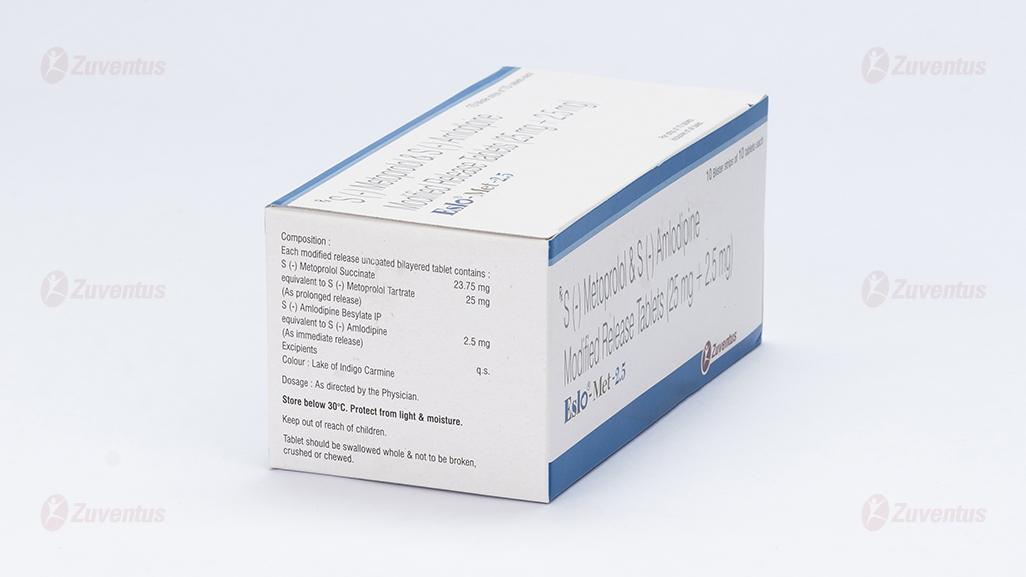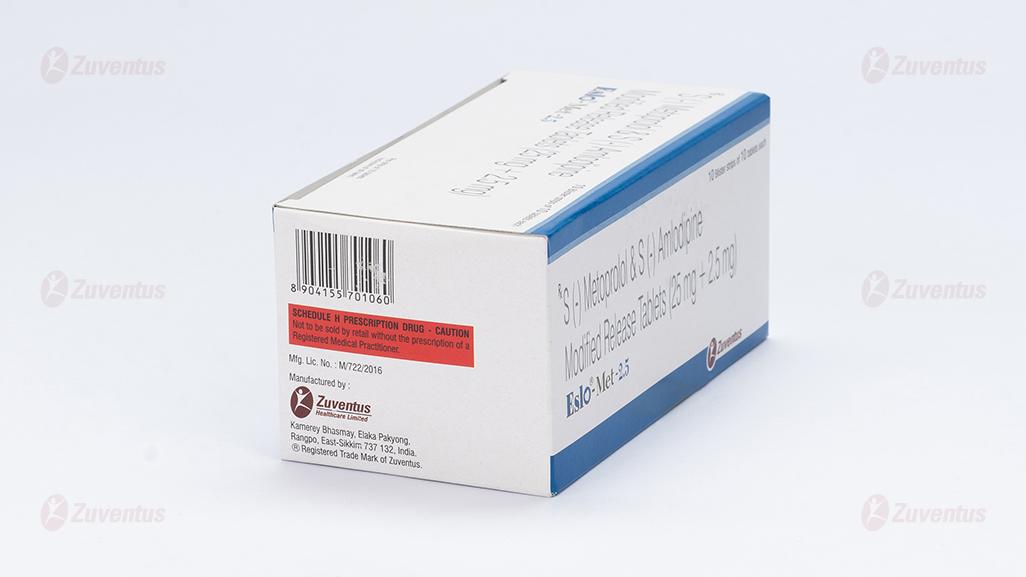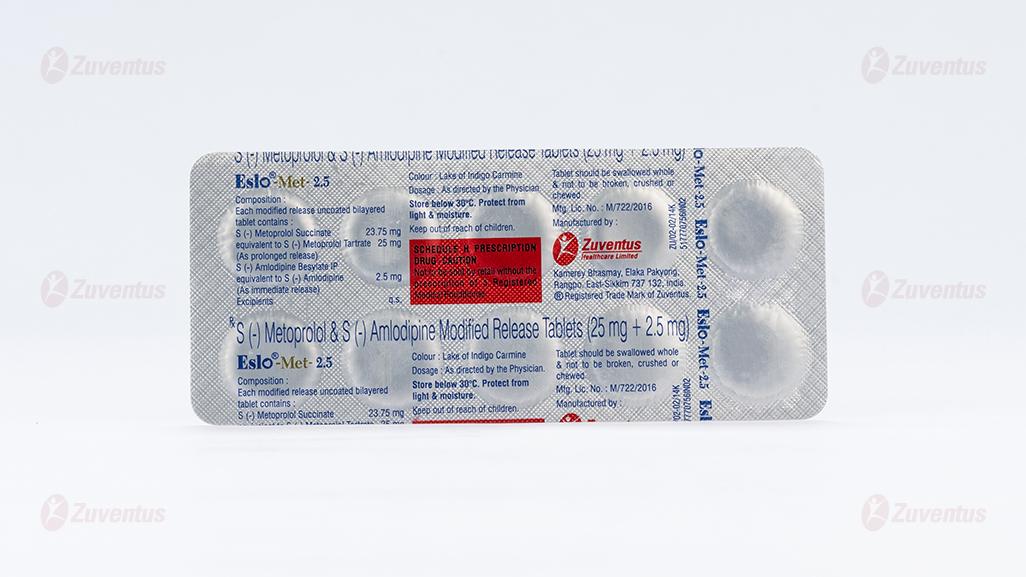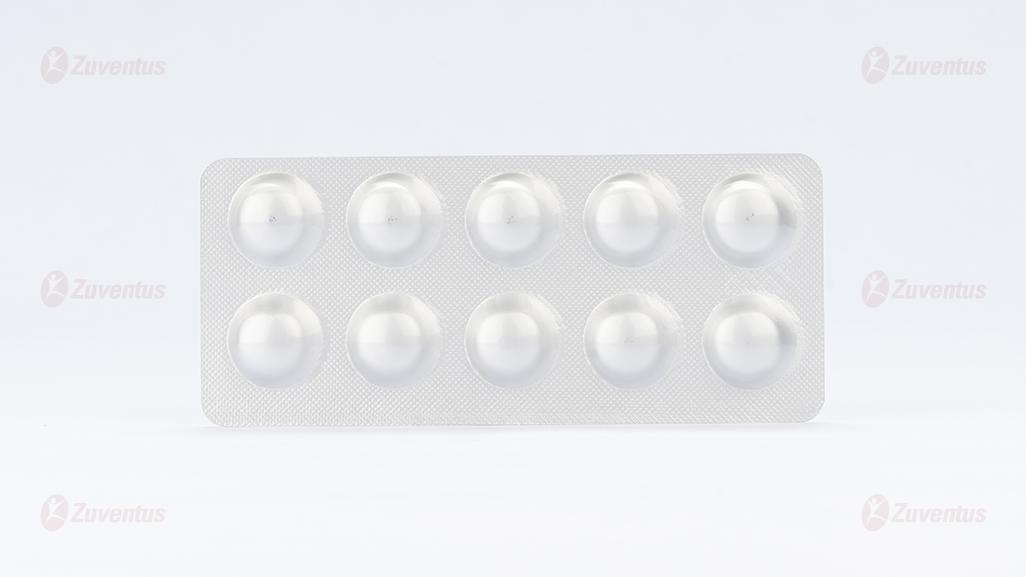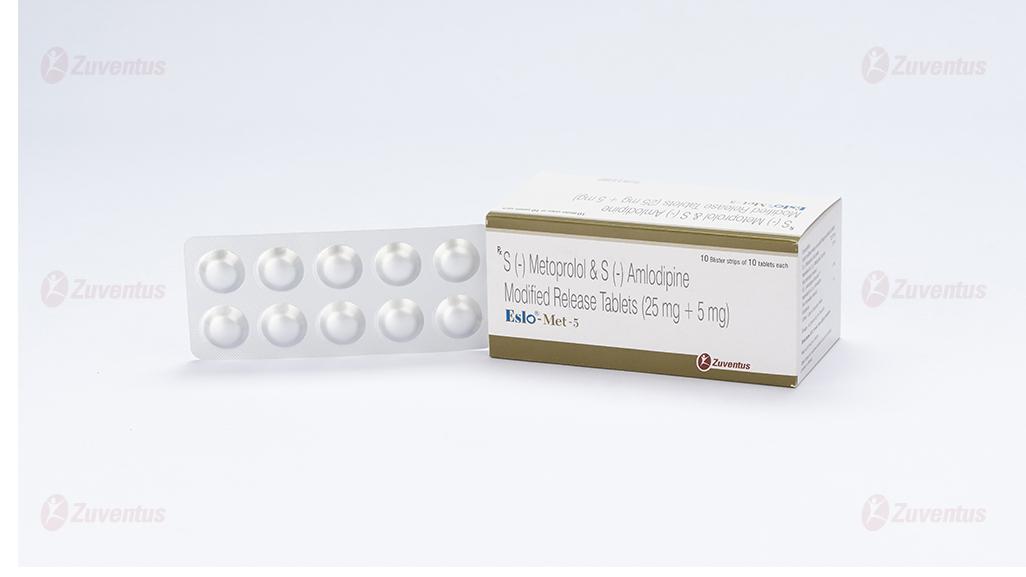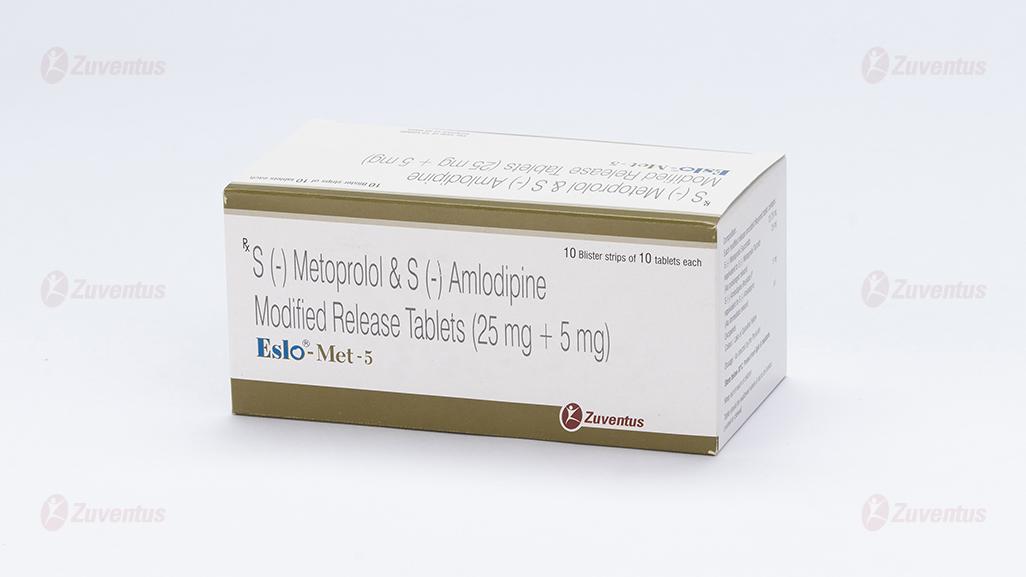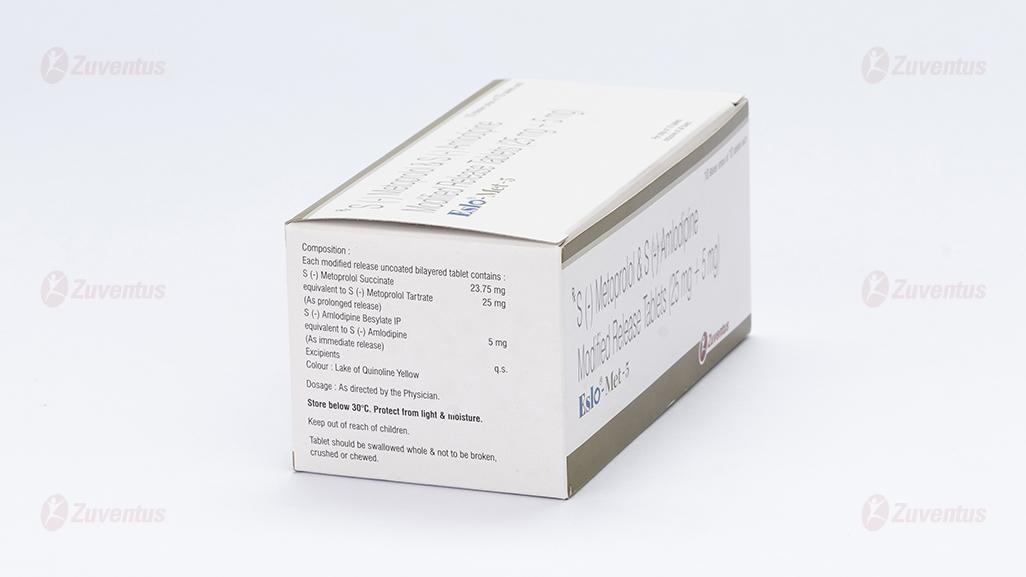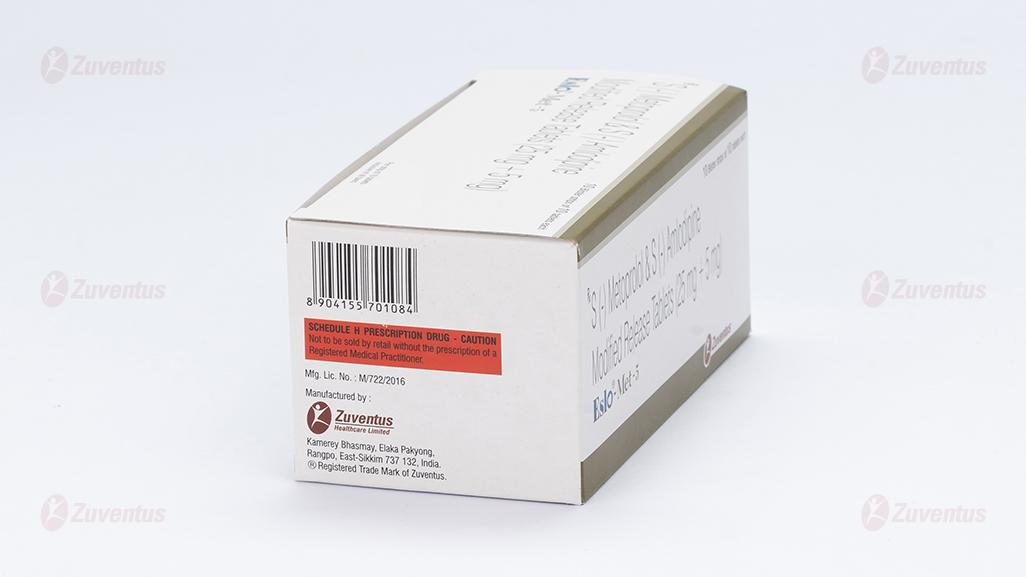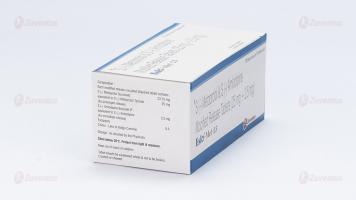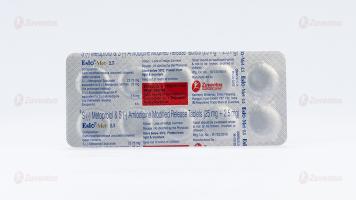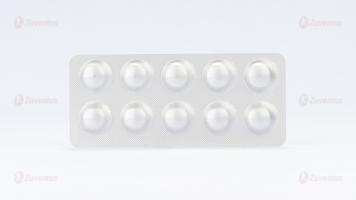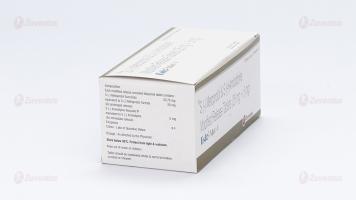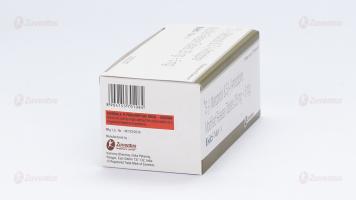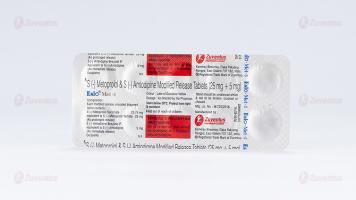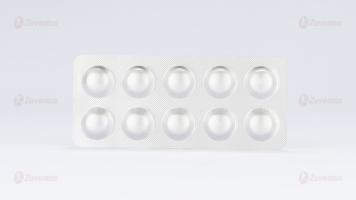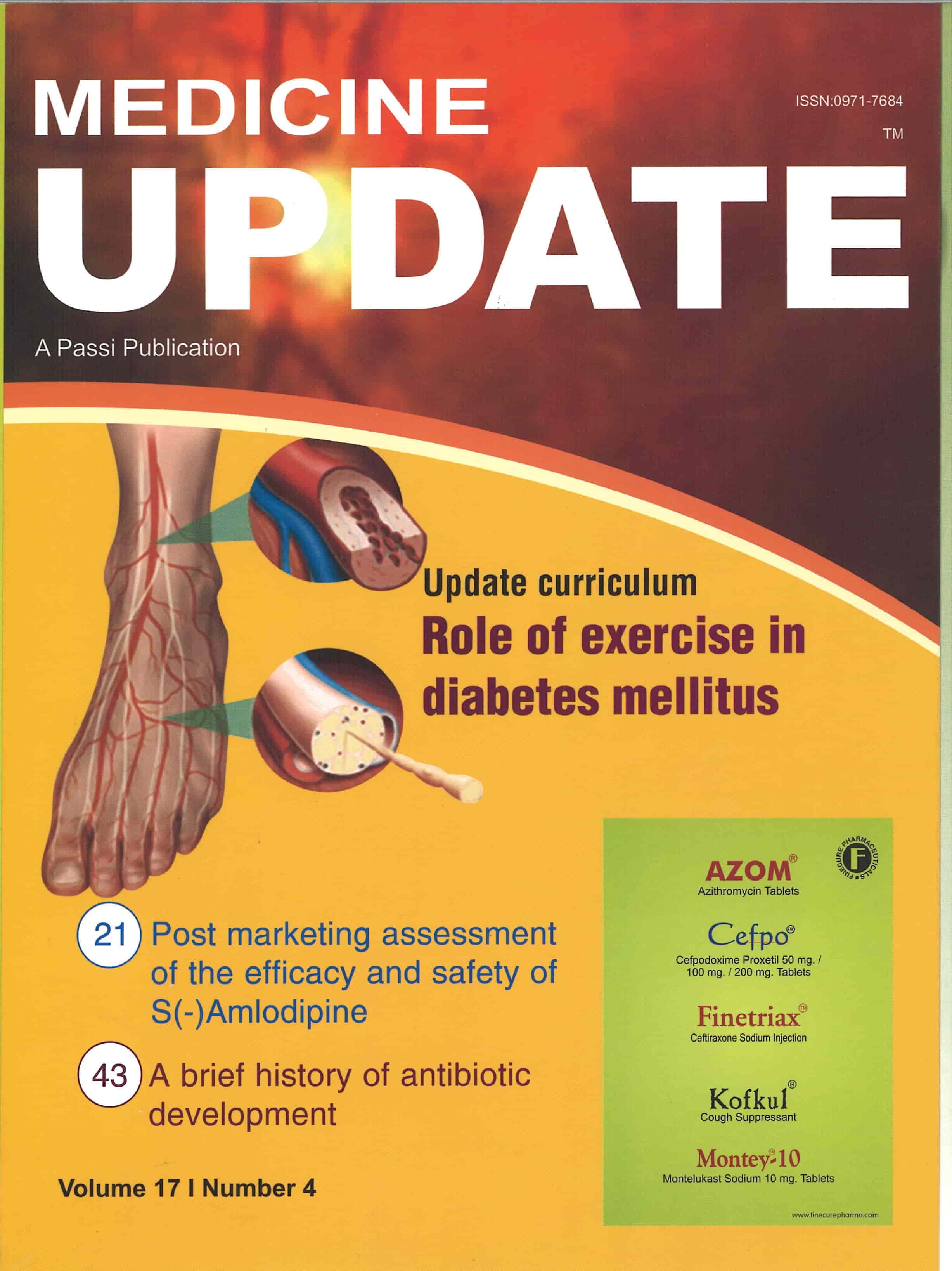Eslo-Met-2.5 & 5 Tablets
Therapy Area
Cardiology
Composition
Eslo Met 2.5
Each modified release uncoated bilayered tablet contains :
S (-) Metoprolol Succinate 23.75 mg
equivalent to S (-) Metoprolol Tartrate 25 mg
(As prolonged release)
S (-) Amlodipine Besylate IP equivalent to S (-) Amlodipine 2.5 mg
(As immediate release)
Excipients q.s.
Colour : Lake of Indigo Carmine
Eslo Met 5
Each modified release uncoated bilayered tablet contains :
S (-) Metoprolol Succinate 23.75 mg
equivalent to S (-) Metoprolol Tartrate 25 mg
(As prolonged release)
S (-) Amlodipine Besylate IP equivalent to S (-) Amlodipine 5 mg
(As immediate release)
Excipients q.s
Colour : Lake of Quinoline Yellow
Description
S (-) Metoprolol is a selective β1-receptor blocker and it is the active form of the racemate Metoprolol. The β1 receptor affinity of S (-) Metoprolol is about 500 times greater than that of R (+) Metoprolol. S (-) Amlodipine is a dihydropyridine calcium channel blocker with vasodilating properties. S (-) Amlodipine is 1000 times more potent than the R (+) isomer in binding to the dihydropyridine receptor. S (-) Amlodipine is the active form of the racemate Amlodipine.
Mechanism of Action
S (-) Metoprolol is a selective β1-receptor blocking agent. Blockade of β1-receptors results in reduction of heart rate, cardiac output and blood pressure. The beneficial effects of β-blocking agents in angina are related primarily to their hemodynamic effects i.e. decreased heart rate, blood pressure, and contractility-which decrease myocardial oxygen requirement.
S (-) Amlodipine is a dihydropyridine calcium channel antagonist that inhibits the transmembrane influx of calcium ions into vascular smooth muscle and cardiac muscle. S (-) Amlodipine is a peripheral arterial vasodilator that acts directly on vascular smooth muscle to cause a reduction in peripheral vascular resistance and reduction in blood pressure. Reduction in the peripheral vascular resistance benefits the patients with angina of effort. In cardiac muscle, blockade of calcium channel results in reduction in the contractility of the heart and decrease in sinus node pacemaker rate and decrease in atrioventricular node conduction velocity. Cardiac output is also reduced. The reduction in cardiac mechanical function reduces the oxygen requirement in patients with angina. Reduction in coronary arterial tone has been demonstrated in patients with variant angina.
Pharmacokinetics
In humans absorption of S (-) Metoprolol is rapid and complete. Metoprolol is eliminated by several pathways, including benzylic hydroxylation (alphahydroxylation) which accounts for ~ 10% of the dose. This pathway is stereoselective for S (-) Metoprolol. The major pathway is O-demethylation that favours R (+) Metoprolol and accounts for 65% of the dose of racemic Metoprolol.
Administration of S (-) Amlodipine 2.5 mg as a single dose in the fasting state produced maximum plasma concentration (Cmax) of 8.30 ± 1.071 ng/ml in 2.73 ± 0.88 hours (Tmax). The mean AUC0-t value (t=48 hours) of S (-) Amlodipine (2.5 mg) was 95.33 ± 14.45 ng-hour/ml. The AUC0-∞value recorded was 140.91± 28.06 ng-hour/ml.
Indications
Eslo Met is indicated for the treatment of essential hypertension and angina pectoris in adults.
Contraindications
In patients who have shown hypersensitivity to any component of the product or to other beta-blockers or calcium channel blockers.
In atrioventricular block of second or third degree, patients with unstable decompensated cardiac heart failure (pulmonary oedema, hypoperfusion or hypotension), patients with continuous or intermittent inotropic therapy acting through beta-receptor agonism, marked clinically relevant sinus bradycardia, sick-sinus syndrome, cardiogenic shock and severe peripheral arterial circulatory disorder
S (-) Metoprolol should not be given to patients with suspected acute myocardial infarction as long as the heart rate is <45 beats/min, the PQ-interval is >0.24sec orthe systolic blood pressure is<100mmHg.
Dosage and Administration
One tablet to be taken once daily, orally. The dose may be titrated as per requirement.
Overdosage
In case of Eslo Met overdosage, unabsorbed drug should removed by induction of emesis and / or gastric lavage.
Potential signs and symptoms associated with overdosage of S (-) Metoprolol are bradycardia, hypotension, bronchospasm and cardiac failure. There is no specific antidote. Symptoms of S (-) Metoprolol overdosage should be treated with atropine, vasopressors, β2-stimulating agents and drugs for cardiac failure.
Overdose with S (-) Amlodipine may result in excessive peripheral vasodilatation. Marked and probably prolonged systemic hypotension up to and including shock with fatal outcome have been reported. The patient should be closely monitored, and the treatment should be symptomatic and supportive. Management depends on the time since ingestion and the severity of the symptoms. Serum electrolytes and creatinine should be monitored frequently.
Warnings and Precautions
Intravenous administration of calcium antagonists of the verapamil-type should not be given to patients treated with beta-blockers
Patients suffering from heart failure should have their decompensation treated both before and during treatment. Abrupt interruption of the medication is to be avoided.
Sudden withdrawal of beta blockade is hazardous, especially in high-risk patients, and may aggravate chronic heart failure as well as increase the risk of myocardial infarction and sudden death. Any withdrawal of the product should therefore, if possible, be made gradually over at least two weeks when the dose is reduced by half in each step, down to the final dose. The final dose should be given for at least four days before discontinuation. If symptoms occur, a slower withdrawal rate is recommended.
Though clinical studies in patients with normal liver function have shown that there is no elevation in the hepatic enzymes with the use of S (-) Amlodipine, caution should be taken while administering S (-) Amlodipine to patients with hepatic and renal impairment.
Special Population
Pregnant women & Nursing Mothers
No data available; the product should be administered only when the potential benefits outweighs the risk to the patient.
Children
Safety and effectiveness not established.
Adverse Effects
Gingival Hypertrophy & Alopecia have been reported with S (-) Amlodipine use. On the basis of clinical data available, the following adverse events have been reported in less than 2% of patients with S (-) Amlodipine : vertigo (0.05%), tachycardia (0.05%), cough (0.05%), headache (0.43%), difficulty in breathing (0.1%), and facial puffiness (0.05%). Fatigue, dry mouth, dizziness, dyspnoea and mild rash have been reported with S (-) Metoprolol.
Storage
Store below 30°C. Protect from light & moisture
Keep out of reach of children
Presentation:
Eslo Met 2.5 : A blister strip of 10 tablets.
Eslo Met 5 : A blister strip of 10 tablets.
About leaflet
Read all of this leaflet carefully before you start taking this medicine because it contains important information for you:
- Keep this leaflet. You may need to read it again.
- If you have any further questions, ask your doctor or pharmacist.
- This medicine has been prescribed for you only. Do not pass it on to others. It may harm them, even if their signs of illness are the same as yours.
If you get any side effects, talk to your doctor or pharmacist. This includes any possible side effects not listed in this leaflet. See section 4.
What is in this leaflet
1. What is Eslo-Met® and what it is used for
2. What you need to know before you take Eslo-Met®
3. How to take Eslo-Met®
4. Possible side effects
5. How to store Eslo-Met®
6. Contents of the pack and other information
1. What Eslo-Met® is and what it is used for
Eslo-Met® tablets contain two substances called S (-)Amlodipine and S (-) Metoprolol. Both of these substances help to control high blood pressure.
− S(-)Amlodipine belongs to a group of substances called “calcium channel blockers”. S(-)Amlodipine stops calcium from moving into the blood vessel wall which stops the blood vessels from tightening. In patients with angina, S (-) amlodipine works by improving blood supply to the heart muscle, which then receives more oxygen and as a result chest pain is prevented.
− S (-) Metoprolol belongs to a group of medicines called beta-blockers. S (-) Metoprolol slow the heartbeat, lessens the force with which the heart muscle contracts and reduces blood vessel contraction in the heart, brain, and throughout the body.
This means that both substances help stop the blood vessel tightening and prevent chest pain. As a result, the blood vessels relax and blood pressure is lowered.
Eslo-Met® is used to treat high blood pressure and angina (chest pain).
2. What you need to know before you take Eslo-Met®
Do not take Eslo-Met®
if you are allergic to S(-)Amlodipine, amlodipine, S (-) Metoprolol, any drug of a related class, or any of the other ingredients of this medicine (listed in section 6).
If you have severe low blood pressure (hypotension).
If the blood flow from the left side of your heart is obstructed (e.g. if you have a narrowing of the aortic heart valve (aortic stenosis).
If you suffer from heart failure after a heart attack.
If you have severe asthma or severe attacks of wheezing, If you suffer from cardiogenic shock (a condition where your heart is unable to supply enough blood to the body).
If you have been told that you have higher than normal levels of acid in your blood (metabolic acidosis)
If you have been told that you have high blood pressure due to a tumour near your kidney (phaeochromocytoma).
If any of the above applies to you, do not take Eslo-Met® and talk to your doctor.
Warnings and precautions
Talk to your doctor before taking Eslo-Met® if you :
have, or have had any of the following conditions:
- Heart failure
- Severe increase in blood pressure (Hypertensive crisis).
- Liver disease
suffer from asthma, bronchitis or any similar lung disorder
have problems with your heart (such as slow heart rate) or circulation (taking this medicine may make these worse)
have diabetes have had a severe allergic reaction to anything
suffer from a rare form of angina called Prinzmetal's angina
will be having an operation which requires a general anaesthetic
have psoriasis
If you are not sure if any of the above apply to you, talk to your doctor or pharmacist before taking Eslo-Met®.
Children and adolescents
The use of Eslo-Met® in children and adolescents is not recommended (aged below 18 years old).
Other medicines and Eslo-Met®
Tell your doctor or pharmacist if you are taking, have recently taken or might take any other medicines. Your doctor may need to change your dose and/or take other precautions. In some cases, you may have to stop taking one of the medicines. This applies especially to the medicines listed below:
In particular, tell your doctor if you are taking any of the following medicines:
- anti-fungal medicines (e.g. ketoconazole, itraconazole)
- so-called protease inhibitors used to treat HIV (e.g. ritonavir, indinavir, nelfinavir)
- rifampicin, erythromycin, clarithromycin (antibiotics)
- hypericum perforatum (St. John’s wort)
- dantrolene (infusion for severe body temperature abnormalities)
- simvastatin (a medicine to reduce blood cholesterol levels)
- tacrolimus, sirolimus, temsirolimus and everolimus (medicines used to change the way your immune system works).
- Eslo-Met® may increase the levels of this medicine in your blood.
- ciclosporin (if you have had a kidney transplant and are taking ciclosporin) as Eslo-Met® may alter the amount of this medicine in your blood.
- Medicines for high blood pressure (including prazosin, clonidine and drugs called calcium channel blockers such as verapamil or diltiazem)
- Other beta-blockers (including those used in the form of eye drops)
- Drugs which affect the peripheral circulation (fingers and toes)
- such as ergotamine which can be used to treat migraine
- Medicines to treat depression Medicines to treat other mental illnesses
- Antihistamines (including medicines that you can buy without a prescription for hay fever and other allergies, colds and other conditions)
- Drugs to prevent malaria Medicines to treat fungal infections
- Medicines which affect liver enzymes, such as cimetidine used to treat stomach ulcers and rifampicin used to treat tuberculosis
- Medicines for heart problems including angina, such as amiodarone, digoxin,
- nitrates and anti-arrhythmic drugs Insulin and other drugs to treat diabetes
- Drugs called NSAIDs used to treat pain and inflammation
- A local anaesthetic called lidocaine.
Eslo-Met® Tablets with food and drink
Grapefruit juice and grapefruit should not be consumed by people who are taking Eslo-Met® Tablets. This is because grapefruit and grapefruit juice can lead to an increase in the blood levels of the active ingredient S(-)Amlodipine, which can cause an unpredictable increase in the blood pressure-lowering effect of S(-)Amlodipine.
Pregnancy, breast-feeding and fertility
If you are pregnant or breastfeeding, think you may be pregnant or are planning to have a baby, ask your doctor or pharmacist for advice before taking this medicine.
Driving and using machines
Your medicine is not likely to affect your ability to drive or use any tools or machines. However, it is best to wait to see how your medicine affects you before trying these activities. If you feel dizzy or tired when taking this medicine, do not drive or use any tools or machines.
3. How to take Eslo-Met® Tablets
Always take or give this medicine exactly as your doctor has told you. Check with your doctor or pharmacist if you are not sure. This will help you get the best results and lower the risk of side effects.
The usual dose of Eslo-Met® is one tablet per day.
− It is preferable to take your medicine at the same time each day.
− Swallow the tablets with a glass of water.
If you take more Eslo-Met® than you should
If you have taken too many tablets of Eslo-Met®, consult a doctor immediately. Take the medicine pack with you so that the tablets can be identified.
If you forget to take or give Eslo-Met®
If you forget to take this medicine, take it as soon as you remember. Then take your next dose at its usual time. However, if it is almost time for your next dose, skip the dose you missed. Do not take a double dose to make up for a forgotten tablet.
If you stop taking Eslo-Met®
Stopping your treatment with Eslo-Met® may cause your disease to get worse. Do not stop taking your medicine unless your doctor tells you to.
4. Possible side effects
This medicine can cause side effects like all medicines, although not everybody gets them.
If you notice any of the following side effects, stop taking this medicine and contact your doctor or go to the nearest hospital casualty department straight away:
- Swelling of eyelids, face lips, tongue and throat which causes great difficulty in breathing or swallowing
- Severe skin reactions including intense skin rash, hives, reddening of the skin over your whole body, severe itching, blistering, peeling and swelling of the skin, inflammation of mucous membranes (Stevens Johnson Syndrome, toxic epidermal necrolysis) or other allergic reactions
- Heart attack, abnormal or irregular heartbeat, faster heart rhythm
- Inflamed pancreas which may cause severe abdominal and back pain accompanied with feeling very unwell Yellowing of the skin or eyes, pale stools, dark urine or stomach pain (these may be signs of liver problems such as inflammation of the liver (hepatitis) or jaundice).
- Yellowing of the skin or eyes, pale stools, dark urine or stomach pain (these may be signs of liver problems such as inflammation of the liver (hepatitis) or jaundice).
Other possible side effects of Eslo-Met®:
Very common (may affect more than 1 in 10 people)
- Swelling which may be due to the retention of fluid in the tissues
Common (may affect up to 1 in 10 people)
- Headache, dizziness, sleepiness, (especially at the beginning of treatment)
- Palpitations (awareness of your heartbeat), flushing
- Abdominal pain, feeling sick (nausea), altered bowel habits which include diarrhoea and
- constipation, indigestion
- Ankle swelling, tiredness, unusual weakness
- Visual disturbances including double vision
- Shortness of breath, muscle cramps
Uncommon (may affect up to 1 in 100 people)
Mood changes (including feeling anxious), feeling depressed, sleeplessness
Trembling, taste abnormalities, fainting
Numbness or tingling sensation in your limbs; decreased sensation
Ringing in the ears
Decreased heart rate
Low blood pressure
Sneezing/running nose caused by inflammation of the lining of the nose (rhinitis), cough
Dry mouth, vomiting (being sick)
Hair-loss, increased sweating, itchy skin, red patches on skin, skin discolouration, rash and hives, purple patches on the skin
Disorder in passing urine, increased need to urinate at night, increased number of times of passing urine
Inability to obtain an erection; discomfort or enlargement of the breasts in men pain, chest pain, feeling unwell Joint or muscle pain, back pain
Weight increase or decrease
Rare (may affect up to 1in 1,000 people)
Confusion
Very rare (may affect up to 1 in 10,000 people)
An increase in infections or fever eg. sore throat, mouth ulcers that you get (due to decreased number of white blood cells), or if you notice that you bruise or bleed more easily or without explanation (due to decrease in the number of blood platelets)
Excess sugar in blood (hyperglycaemia)
A disorder of the nerves which can cause weakness, tingling or numbness
Swelling of the gums
Bleeding of the gums (gingival bleeding)
Abdominal bloating (gastritis)
Liver enzyme increase which may be due
to liver problems such as blockage in the bile duct ‘Measles’ like skin rash.
This may be associated with a high fever and joint pains (erythema multiforme)
Peeling of the skin over large areas of the body Inflammation of blood vessels, often with skin rash
Skin sensitivity to light
Disorders combining rigidity, tremor, and/or movement disorders
If any of these affects you severely, tell your doctor.
Reporting of side effects
If you get any side effects, talk to your doctor, pharmacist or nurse. This includes any possible side effects not listed in this leaflet. You can also report side effects directly: Website: www.zuventus.com and click the “Safety Reporting” located on the top of the home page.
By reporting side effects, you can help provide more information on the safety of this medicine.
You can also report the side effect with the help of your treating physician.
5. How to store Eslo-Met
Keep this medicine out of the sight and reach of children.
Do not use this medicine after the expiry date which is stated on the carton and blister.
Do not store above 30°C.
Store in the original package in order to protect it from moisture.
Do not use any Eslo-Met pack that is damaged or shows signs of tampering.
6. Contents of the pack and other information
What Eslo-Met®-2.5 and Eslo-Met®-5 tablets contain
The active substances of Eslo-Met® are S(-)Amlodipine and S (-) Metoprolol
Eslo-Met®-2.5
Each modified release uncoated bilayered tablet contains:
S (-) Metoprolol Succinate 23.75 mg equivalent to S (-) Metoprolol Tartrate 25 mg
(As prolonged release)
S (-) Amlodipine Besylate IP equivalent to S (-) Amlodipine 2.5 mg
(As immediate release)
Excipients q.s.
Colour: Lake of Indigo Carmine
Eslo-Met®-5
Each modified release uncoated bilayered tablet contains:
S (-) Metoprolol Succinate 23.75 mg equivalent to
S (-) Metoprolol Tartrate 25 mg (As prolonged release)
S (-) Amlodipine Besylate IP equivalent to
S (-) Amlodipine 5 mg (As immediate release)
Excipients q.s. Colour:
Lake of Quinoline Yellow
Presentation
Eslo-Met®-2.5: A blister strip of 10 tablets.
Eslo-Met®-5: A blister strip of 10 tablets.



